|
As
it happens Sainz and Kankkunen (who finished second) took
only five wins between them, a fact which nicely illustrates
the dominance of Auriol and the Delta in 1992.
1993 saw
considerably less success, despite the proven talents of Sainz in the lead car, but by then the Integrale was showing
its age against full factory efforts from Toyota, Ford and
Subaru and marked Lancia’s final tilt at the crown, and
for that matter its last official participation in world
motorsport up to this point.
But,
Lancia were able to make the most out of their glory while
it lasted. If
the road-going Evoluzione's muscle-building, Weetabix-packed looks
were not enough, there were a handful of Special
Editions, including the exclusive Club Italia of which only
15 were built.
The snazzy graphics and flashy colours only made the 'Grale seem more impressive - it had
become a cult object and a symbol of Italy. Clients included
Mauro Forghieri, Luca de Montezemolo, Michele Alboreto and
Dante Giacosa.
If
the 'standard' Evoluzione wasn't sufficiently exclusive, there was
always the Lancia Hyena Zagato, a car which perhaps
epitomised the ultimate Integrale. Designed in 1990 by Marco
Pedracini, and launched as a full-scale model at the
Brussels Motor Show in January 1992, the project was conceived
following a meeting between Andrea Zagato and Paul Koot, the
Lancia importer for The Netherlands.
It
had been almost two decades since Zagato and Lancia had last
created a car, so the Hyena was a particularly emotional
project. Zagato successfully created a masterpiece in
modern design with traditional features such as a
double-bubble roof and minimal overhangs. It was a complete
rethink of the boxy Delta.
After
some sympathy from Lancia, Zagato struck a deal to produce
500 units. Production started at Via Arese in 1993, but the
project was unfortunately stopped short due to management
changes at Fiat Auto (what’s new…) and only 24 examples
were made.
Whilst
on track with special editions, there was also the one-off
Integrale 16V HF cabriolet painted silver for the bon viveur, Giovanni
Agnelli. Due to the handicap of the "Avvocato",
this particular Delta was equipped with an automatic Valeo
electronic clutch. This car perhaps represents the most desirable road-going
Delta of all time.
In the final
analysis, it is apparent that the 'Grale wasn’t
just a brilliant rally car, it was also a sensational road
rocket and one of the finest-driving cars of its era. At the
time of the HF 4WD’s launch, there were other permanent four-wheel drive cars available, but none which had a setup
as advanced or effective as the Delta’s four-wheel drive
system.
|
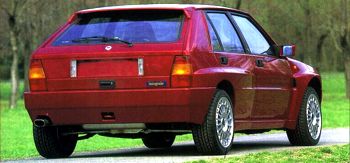
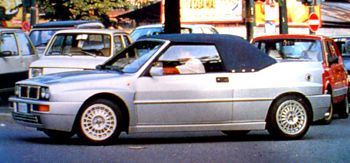
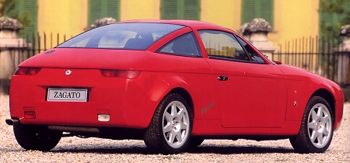 |
|
Ultra
exclusive! Above: the last-of-the-line "Dealer's Collection" special edition,
of which only 180 examples were made. Middle: the one-off Integrale Cabrio for
Giovanni Agnelli boasted an automatic Valeo clutch. Below: based
on the Integrale Evoluzione, the Lancia Hyena
Zagato gave an indication as to what could be done
with the underpinnings of the rally legend. |
|
 |
|
|
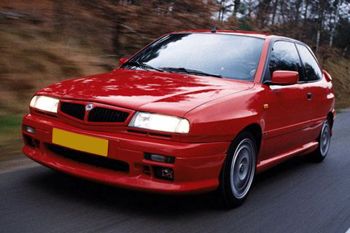
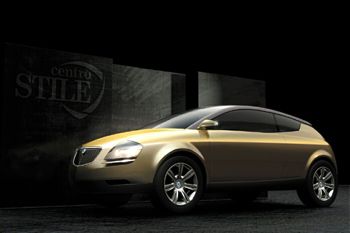 |
Above:
the Delta range of 1995-1999 was never as popular
due to a poor marketing strategy. Unfortunately
the Integrale never made a comeback. Below: Come
on Lancia! Build the damn thing!! The Stilnovo
represents Lancia's potential successor to the Delta, and would be an ideal player in the C-segment. |
|
 |
|
|
Truly, the four-wheel drive Delta, in all its forms, was an
antidote to the sterility which largely marked out new car
releases in the eighties, and was a more than worthy
successor in Lancia’s line of ‘rally cars for the road’,
following as it followed in the footsteps of the Fulvia 1.6 HF,
Stratos, the beautifully elegant 037, and brutal Delta S4. As a
measure of the respect afforded to this car, there was an
owner’s party at the factory to commemorate the last of
the line in November 1994, almost exactly a decade ago this
month.
In fact, there is a small post-script to the Delta story.
Whilst Integrale production had carried on in a small corner
of Maggiora’s Chivasso plant (actually the old Lancia
factory), Lancia themselves had replaced the standard Delta
range with a brand-new Delta in mid-1993. Despite the name,
there was almost no carry-over from the old car – apart
from being based on the platform of the Lancia Dedra,
necessitating all-new suspension and drivetrain layouts, the
body, although recognisably carrying styling cues from the
original, had no parts in common. Designed by IDEA and
originally launched in
five-door form, a three-door version, designated ‘HPE’ (an old Lancia name dating back to the days of the Beta),
was unveiled in 1995. This car was actually conceived with
more the look of a coupe, and elements of that look did
indeed make it into production.
Sales
for the Delta II were, however, disappointing, and when it
was finally killed off in late 1999, it was not replaced
owing to a projected lack of demand. Even though the Delta’s
sales were miniscule by the end – a piffling 9,000 were
sold in 1998 – the problem seems to have been not the car
itself, which was a competitive proposition when stacked up
against rivals, but a dearth of effective marketing. The
death of the Delta also marked the demise of the last
overtly sporting Lancia, the Delta HF HPE, which also marked
the last home of the classic Aurelio Lampredi-designed
twin-cam (in turbocharged 193 bhp form).
It
has now been five years since the last Delta was made, five
years which have seen Lancia’s sales suffer a steep drop
and only recently get back on a steady footing. One can’t
help but feel that now is an appropriate time to start
thinking about a Delta III.
Such
a car, perhaps drawing on design cues from the 2003
Granturismo Stilnovo concept, in returning Lancia to
Europe’s biggest segment, the C-sector, would
help to re-establish Lancia as a genuinely significant
player once again. Lancia’s
key brand characteristics of sophistication, style and
sportiness precisely match the demands of buyers in this
sector, and provided it is executed well, there seems to be
no reason why it should not be as successful as the original
which kicked off the whole prestige hatch phenomenon in the
first place.
By
Shant Fabricatorian
Page
4/4 |
|
![]()
![]()